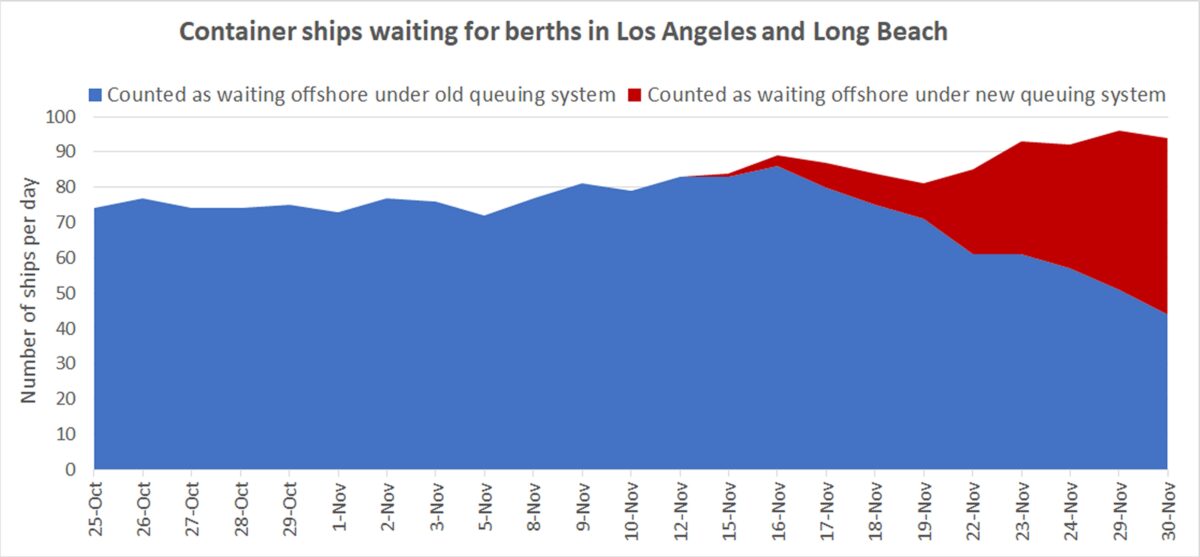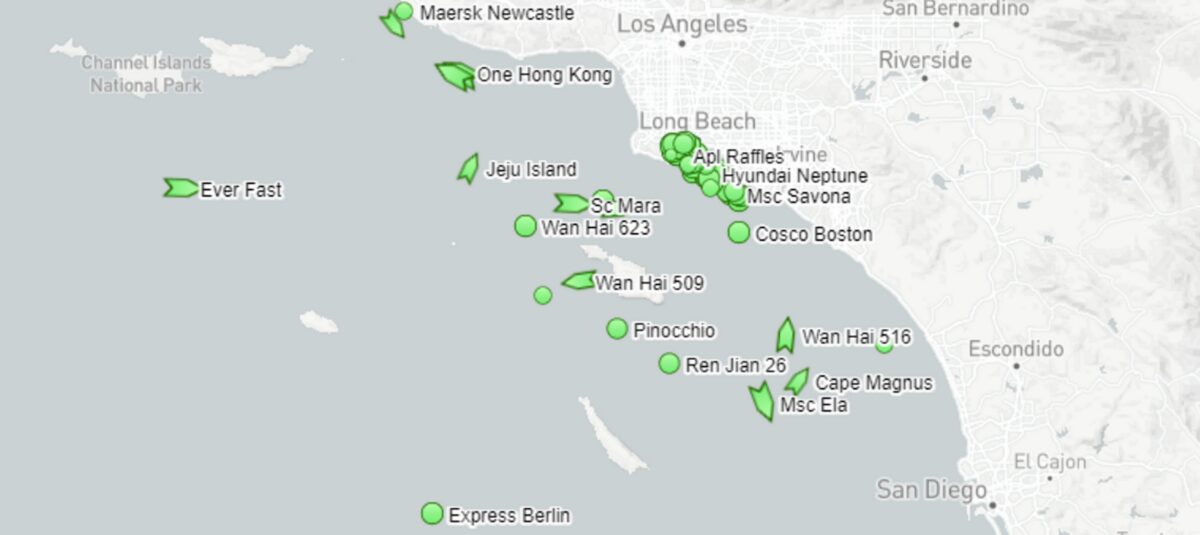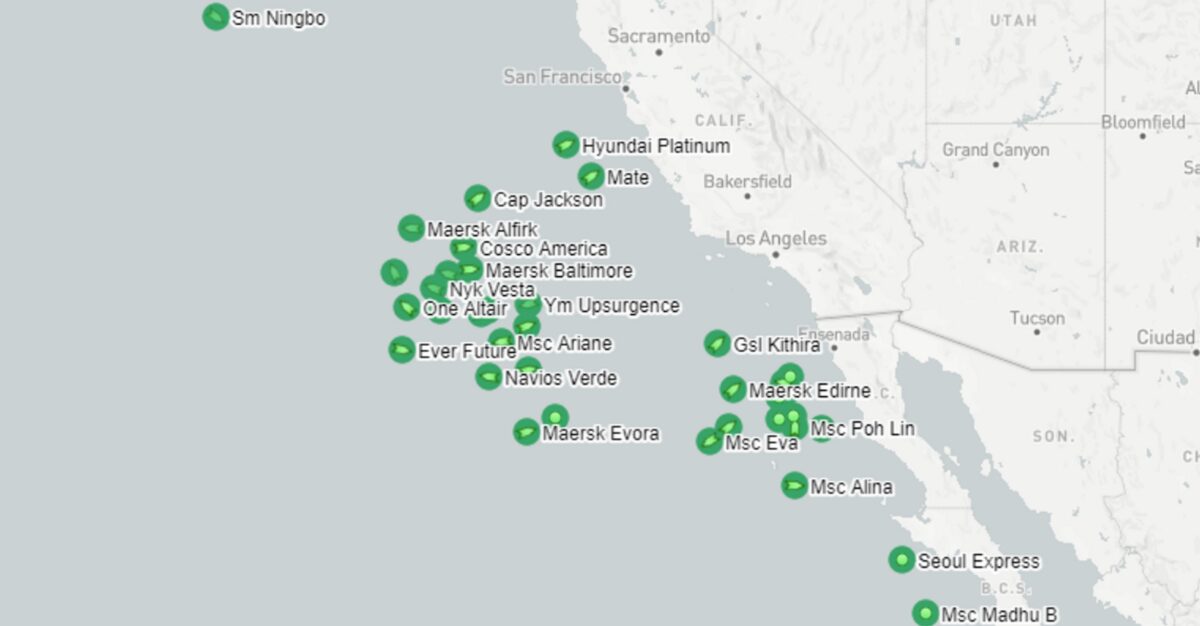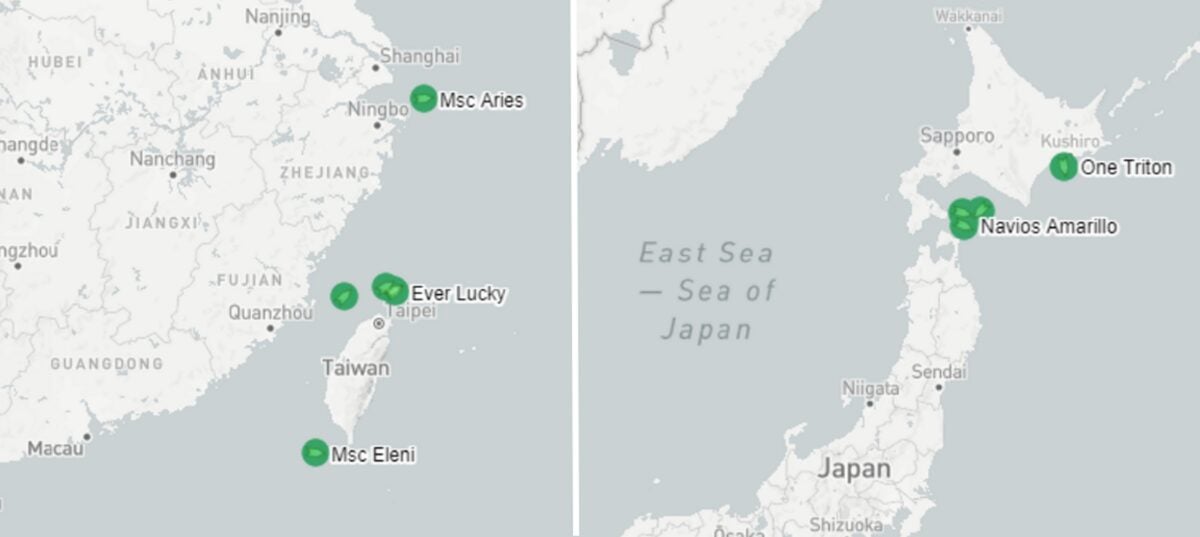The decline in ships waiting just offshore of Los Angeles/Long Beach continues to be touted as a sign that port congestion is easing — despite the fact that the true number of waiting ships has not actually declined.
Gene Seroka, executive director of the Port of Los Angeles, said during a press conference Tuesday while standing alongside Labor Secretary Marty Walsh: “Since we instituted a penalty for long-aging containers, the number of ships at anchor has decreased by more than 40% over a four-week period. We have not collected a nickel of that penalty yet. We put it out there to motivate people and it has done just that.”
Mario Cordero, executive director of the Port of Long Beach, said in response to a CNBC commentator on Nov. 24: “I think it’s a fair representation that there’s been progress, and I think, as you just noted, the president referencing the fact that the vessels at anchor have been diminished. We’re having some progress in addressing the capacity constraints at the terminals in the San Pedro Bay complex, particularly here at the Port of Long Beach.”
The number of container ships at anchor or loitering within 40 miles of the ports has indeed diminished. The reason: Since mid-November, a new queuing system has encouraged ships to wait outside of a specially designated Safety and Air Quality Area (SAQA) that extends 150 miles to the west of the ports and 50 miles to the north and south.
The overall queue, including container ships both inside and outside the SAQA, has not diminished. It reached a new milestone on Tuesday. For the first time, there were more container ships waiting outside the SAQA than inside the ports’ 40-mile zone.
According to the Marine Exchange of Southern California, there were 44 container ships waiting within the 40-mile zone as of midday Tuesday. Based on Marine Exchange data, American Shipper estimates that there were 50 container ships waiting outside the SAQA.
The total — 94 — was just shy of Monday’s all-time record of 96 (including ships outside the SAQA), and up 27% from the count on Oct. 25, the day the excess-dwell penalty plan was announced by Seroka and Cordero.

More Marine Exchange visibility coming soon
The Marine Exchange is about to provide more transparency on all of the container ships waiting in the Pacific, whether inside or outside the SAQA.
The new queuing system reserves a ship’s spot in line based on its calculated time of arrival (CTA) as opposed to when it gets within 20 miles of the ports.
The CTA is derived from when a ship would have hypothetically arrived from its last port of call, as calculated by the Pacific Maritime Monitoring System (PacMMS). The ship can then wait anywhere it wants outside the SAQA — even on the other side of the Pacific — knowing it has a spot saved in line based on its CTA.
A ship’s CTA, check-in time and arrival time are recorded in the Marine Exchange’s Master Queuing List (MQL). That MQL is now publicly posted twice daily (see here).
As explained by Capt. Kip Louttit, executive director of the Marine Exchange of Southern California, in his daily note to clients and media on Tuesday, the container ships in the queue that are outside the SAQA are the ones that have a CTA listed but do not yet have check-in or arrival times.
American Shipper estimated the number of waiting ships outside the SAQA by counting those with a CTA earlier than the time the midday Master Queuing List was generated, on the premise that this is the best apples-to-apples comparison with the old count, as those ships would have theoretically arrived under the old first-come, first-served model.
The Marine Exchange is coming out with its official methodology for calculating the outside-the-SAQA tally later this week. (UPDATE: the new methodology is now out. See story here.)
Louttit wrote in his daily report on Tuesday: “I’ll have methodology to account for the backup on Friday. The focus of this firm and our VTS [Vessel Traffic Service] is a safe, secure, efficient, reliable and environmentally sound marine transportation system in SoCal waters. … As a secondary mission, we’re working with the working group to develop a methodology and data display to account for the ships that are now slow-speed steaming and loitering elsewhere.
“The backup didn’t go away. It’s just in two places — spread to the wide Pacific for safety and air quality — rather than one,” said Louttit, who added, “My VTS watchstanders are giddy with the safety increase we get with every ship that is not loitering in our crowded waters.”
Ship queue spread from Mexico to Asia
Automatic Identification System (AIS) ship-positioning data from MarineTraffic reveals the locations of all the ships waiting to berth in Los Angeles/Long Beach and confirms just how stretched out the queue has become. AIS data on Wednesday showed a much less crowded field within the 40-mile zone than before the new queuing program began.

Outside of the SAQA, MarineTraffic data showed 40 container vessels with CTAs on or before midday Tuesday waiting off the West Coast, whether off the coast of Mexico’s Baja peninsula or farther offshore of California.

An example of a vessel in these waters and its journey: The 4,250-twenty-foot equivalent unit Navios Verde left Ningbo, China, on Oct. 26, five weeks ago, bound for Los Angeles. It has been loitering on the east side of the Pacific since Nov. 12. But because the Navios Verde is outside of the 40-mile zone, it is not counted as loitering “in port.”
There were 10 additional vessels with CTAs on or before Tuesday waiting in Asian waters: four off Japan, five off Taiwan and one off Ningbo.

Assumedly, container ships waiting offshore of Asia that have CTAs in Los Angeles/Long Beach on or before Tuesday do not have a terminal slot until at least mid-December, given that they still need to cross the Pacific Ocean to get to their destination.
One of those ships is the 14,220-TEU YM Wisdom, destined for Long Beach. It left Yantian, China, on Nov. 7. It was assigned a CTA of Nov. 25. It sailed north and is now loitering offshore of Hokkaido, Japan, a week after it could have been in California waters had it immediately crossed.
Click for more articles by Greg Miller
Related articles:
- It’s official: 96 container ships are waiting to dock at SoCal ports
- California ship pileup still piling up — but out of sight, over horizon
- Congestion, falling arrivals hit Southern California import volume
- How to make a billion when your ships are stuck at anchor
- Last-minute reprieve: LA/LB delays pulling trigger on congestion fee
- Clock ticks closer to midnight for overwhelmed California ports
- $25B worth of cargo stuck on 80 container ships off California









Robert C
The REAL problem is China is refusing to take back used containers, so they can inflate their economic numbers by building new ones.
KunaKurmudgeon
Yeah, so that 110 miles is about 8,000 FEU, so one container ship. You’re welcome.
Ted
The last 3 days in a row. I as a 40 yr cdl driver have witnessed a solid double line of Trucks stretching from Coachella to Blythe and beyond. A distance in excess of 110 miles. And nearly the same volume flowing west. I don’t believe there’s a driver shortage or a broken supply chain. I believe that the the world and by extension the U.S. population has reached a point where the consumers ability to consume has surpassed the producer’s ability to keep up with it. Nature is going to find its equilibrium for this and it’s going to be ugly.